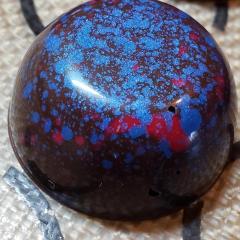Search the Community
Showing results for tags 'Dessert'.
-
At the risk of being labelled heretic on this forum I'd like to raise a cooking question and solicit advice from it's knowledgeable members. Yesterday I attempted to make a carrot cake. This was to be sold at a charitable vide grenier in our village. Naturally, as it was an American dish made by am American I wanted it to be as good as possible so as to not look bad to our French neighbours. Although by no means a disaster the cake did not rise nearly as high as I would have expected it to. It did rise, but each of the layers was somewhere between 1/2 & 1 inch flatter than I thought it should have been. (taste was fine, but it was denser than it should have been.) I don't make a lot of cakes, but I have noticed that whenever I do they don't rise to their full 'potential' I also note that French cakes in general don't seem to be as high or light as American ones. I used French cake flour & added both baking powered & baking soda (this was the passover carrot cake recipe on recipe Gullet) and followed the recipe faithfully. Any ideas? Does anybody else have the same problem? Secondary question: I'm running out of both baking powder & baking soda and I don't see either of them in the local hypermarket. Where can I find them?
-
I'm populating my Christmas wish list with fun kitchen things. One item I've wanted for a while is a cream whipper, ISI seems to be the way to go, but there are a lot of options. I guess a pint one is the most versatile, but even those come in a wide range of price. I don't really care if it's stainless stell, brushed, painted or tiled, dipped in lava or what ever, as long as it works and doesn't look like I pulled it from the trash. But there's also the Thermo Whip, which is an insulated container. Seems neat, as it keeps things cool or hot for hours, but I can imagine that this also will hinder in the production of things that need to be cooled in the fridge before making a foam etc. The insulation works both ways, so cooling something warm in there in the fridge might take a very very long time. I guess I could keep something warm or cold in an according waterbath instead, what would you pick? Oh, and I'll most likely never make whipped cream in there, as I can't stand that stuff, but fluffed soups, deserts of some kind, things like that are of interest. I'm tending towards a regular steel one, but am curious to hear of others that might have one of these, especially if you have the thermo. Thanks! Oliver
-
Is there any difference between the two other than the thermal whip being insulated? Can I use the regular dessert whip to make a hot foam if I put the liquid to be foamed in just prior to using it? Does anyone have use doing this technique, and if so, how long do things stay warm in the dessert whip?
-
So I wanted to keep a meringue in a isi to have thru service to torch on top of a dessert. Is there a way to keep a basic meringue in an isi, or a marshmallow-y fluff in an isi. I really looked around but couldnt find a thing. thanks in advance for the help.
-
Limited usage with isi but to have a foam/ froth with butter or browned butter would really work in this application. Can anyone help me out with a good method? thanks in advance.. danny
-
Ok so I have a question. I use my whipper a lot for whipped cream (My fiance loves it). But, I want to make a smoother whipped cream. Typically I whisk together a pint of heavy cream, a few tablespoons of powder sugar and a splash or two of vanilla. I charge it with 1 cream charge, shake and go. But, it is very...stiff...for lack of better terms. Whenever I go to Starbucks and they use their whippers they get a really smooth texture. What can I do to make a better, smoother cream? Thanks!
-
Hi everybody, Pectins. Well I am trying to do some research on Pectins. The Bought kind. From the ideas in food blog and reading i have discovered there are basically 2 types of pectins. HM Pectin (The one you know, Requires acidic conditions and Sugar to set, Has different seeting speeds available) & LM Pectin is thermo reversible) (Low Ester, Requires Calcium to set. Hence Pomona comes with calcium satchels) However, In recipes recently the chefs are using some pectins which have confused me. Ok Grant Achatz uses "Yellow Pectin" & "Pectin NH" along with others including Adriano Zumbo (Zumbo uses it for his Glaze amongst many other things, which he reheats everytime he needs it over double boiler to 35degrees Celcius) I have the following Pectins at home and am trying to match which ones equal what in the recipes. Genu Pectin Type 101 AS (This is a LM amidated Pectin) Brown Ribbon HV (HM Pectin) GENU pectin type D slow set-Z (HM Pectin, Slow setting) This one is referred to as Yellow at Le Sanctuaire) So there you have it I have Solved the Yellow Pectin problem. Its a slow set HM Pectin. I suspect I could swap the Brown ribbon with The genu pectin Type D slow set. I'll test that and get back to you. So the question remains what the bleep is Pectin NH. Ok So i do know that Pectin NH is a LM amidated Pectin. So I would suspect the LMA pectin I have would be fine. I know that it requires calcium to set, and so many of the recipes it is mentioned in does not have any calcium added? so what is going on. I noticed at the paddymelon website in Melbourne, Australia that it states it is standardised with Polyposphate, Calcium Citrate & dextrose. And Louis Stab information sheets says it has Sodium Diphosphate and Calcium Orthophosphate in it. So I've found a few clues there. Seems that Pectin NH is LMA pectin with Calcium in it, now to work out the concentration. I'll have to do some tests. Has anyone anymore knowledge on this topic? Please add, correct delete and contribute to the discussion. I really don't want to reinvent the wheel. I also don't want to buy Pectin NH if i really already have it. Also asking as to why you would choose Pectin over other Colloids like Gelatin, Gellan, etc. Does anyone kno what brands of Pectin they use at Alinea, French Laundry, Fat Duck & Zumbo? Kindest regards, Vol
-
- Confections
- Dessert
-
(and 1 more)
Tagged with:
-
Hello! I'm fairly new to this site so I don't know if my search was weak. I'm trying to find a way to make Mandarin orange puree at home, but I couldn't find anything even similar in the forum. I am a home cook, but I have been making chocolate bonbons and other confections for over 4 years (intermitantly). It is too expensive for me to purchase this online- not because of the price of the puree, but the cost of shipping makes it prohibative. The recipes I've seen online are all differant and don't seem to be what I need. I would love any help with this! I look forward to hearing and learning from those who have much, much more experience than me. Thanks!
- 5 replies
-
- Confections
- Recipe
-
(and 3 more)
Tagged with:
-
I have a question for Steve Klc. Once a cake is covered with rolled fondant, can it then be refrigerated, or will it become sticky and absorb odors? And can you give any recommendations on how to cover, decorate and safely deliver a six tier wedding cake?
-
I attempted to make genoise, the Italian sponge cake, back in the late 1990s. After several turns, I gave up. A few days ago, I decided to try again. The end result was better, but I still had tiny balls of flour in the mix. Any suggestions? Here's what I did - I used half cake flour and half all-purpose flour, mixing the flours with salt and 2 tablespoons of the sugar; heated all of the eggs and the sugar to 90 degrees Fahrenheit over hot water then beat on high for 2 minutes followed by 12 minutes at medium speed of a stand mixer; sifted the flour and sugar mixture over the batter then gently folded the flour in; it took five intervals of folding; folded the vanilla extract and a bit of heavy cream with 1 cup of the batter then added the new mixture to the batter. I used a sheet pan. Well, the batter did deflate some and I still ended up with balls of flour. It tasted great though was less than an inch (less than 2.54 cm) thick. What is the secret to folding in flour without getting bits of it in the baked product? I have made a similar recipe using room temperature eggs and adding the flour while the mixer was turned on. No flour balls, but the baked cake does shrink quite a bit; I used a sheet pan and cupcake pans. Thanks for your help!
-
I'm trying to make a spongecake and it is just awful. The cake is dense, eggy and crunchy. Is it supposed to be like this until I add the syrup? I don't think the addition of syrup would help all that much. Anyway, here is the recipe. 225g AP Flour 6 Eggs 160g Caster Sugar 75g Butter, melted Add sugar to eggs in a heatproof bowl and beat over simmering water until a ribbon consistency. Remove from heat and allow to cool for three minute. Add cool butter and sifted flour, using a large metal spoon to fold in until just combined. Split evenly into two 8" pans and bake at 350°F for fifteen to twenty minutes, checking doneness with a skewer. Cake is done when the center bounces back after slight pressure. Now, I have tried replacing the AP flour with cake flour and a combination of cake flower and cornstarch and I still get an eggy, crunchy texture. I have tried adding warm butter directly to the batter as well as cooled melted butter. I have tried adding a little batter warm butter, then combining all of the batter together but butter still weeps out of the batter. Regardless of what I do, I am deflating the batter as soon as I add butter to the it. With the flour, I can fold in fairly quickly without deflating the batter but if I do that I am left with clumps of flour in the batter that I generally fish out. If I go slower, I can incorporate the flour more thoroughly but I find I lose quite a bit more air. So, what am I doing wrong and where do I go from here? I thought this was going to be the easiest recipe out of the book because it has the fewest ingredients and steps but I have been through a dozen cakes and I still can't get it to look more like a cake and less like Vietnamese baked eggs?
-
Hi everyone, I have to invest into new round cake pans, over the past years I have been using two different depths, either 2" or 3". I was wondering what everyone here likes using. I like using both sizes, but I would like to pick one size and stick with it. Any Thoughts? Matt








